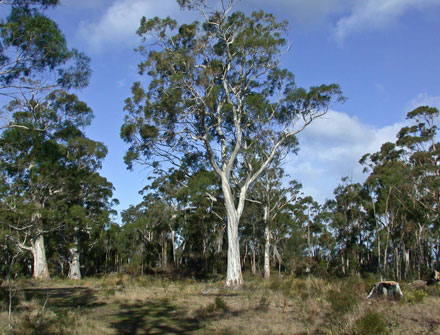
The two species that grow well in hotter, drier areas are eucalyptus camaldulensis and eucalyptus tereticornis. Source: New Vision Uganda
Growing Eucalyptus well is not easy and requires careful cultural practices, especially the use of improved seeds, intensive land preparation and thorough weeding (both pre and post-planting).
The main species, eucalyptus grandis, will only grow well in areas with good rainfall and deep, fertile soils.
Twaha Kakooza, who owns 100 acres of eucalyptus in Uganda, says there are a number of suitable eucalyptus species to grow for large-sized poles and also for timber, especially where there are deep, fertile soils and mean annual rainfall greater than 1250mm (Eucalyptus grandis will usually perform best in such conditions).
Kakooza says as long as one uses improved seeds, eucalyptus grandis will produce large, straight stems and could provide you with a good income from two to three years (building poles), large poles by eight years and timber from around 12 years onwards.
The two species that grow well in hotter, drier areas are eucalyptus camaldulensis and eucalyptus tereticornis.
They, however, do not produce good saw timber. They are more suited to fuel wood production in regions where eucalyptus grandis is not suited.
Trials have been done on eucalyptus cloeziana, eculayptus pellita, eucalyptus urophylla, eucalyptus dunnii, eucalyptus longirostrata and corymbia citriodora var.variagata (previously eucalyptus citriodora).
Isaac Malinga, who also grows eucalyptus, says the only local seed source recommended is the National Forestry Authority’s Fort Portal seed stand.
Nearly all the other local eucalyptus grandis seed sources have hybrid and are not pure seeds.
The South African eucalyptus grandis seed is usually clean (had the chaff removed) and should produce well over one million plants per kilogram.
Most other eucalyptus grandis seed will be un-cleaned, with expected seedling yields closer to 100,000-150,000 per kg (note: Always check the germination rate with each batch of seed from the seed supplier).
Kakooza says when growing eucalyptus for timber or large poles, the plant stocking (spacing) should not be as dense as for fuel wood and small poles.
For fuel wood and small building poles, a higher stocking compared to timber crops is justified, especially as the rotation is only a few years.
Malinga explains that common eucalyptus grandis stockings for fuel wood range from 1,337 to 2,500sph depending on the nature of the site and the size of poles required (note: higher stockings will generally produce a lot of smaller poles, if larger poles are required, reduce the stocking).
The following plant spacements are common for fuel wood crops. 2.7×2.7m (1337sph) 2.5×2.5m (1600sph) 3.0×0.2m (2,000sph) or 2.0×2.0m (2500sph).
The same golden rules for establishment of all eucalyptus crops apply; thorough land preparation, pre-plant weed control, planting only good quality seedlings, planting early in the rains, blanking (infilling) no later than three weeks after the initial planting and most importantly, regular weeding in the first few months after planting.





